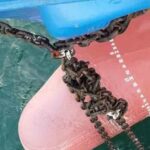Real Life Accident: Ship’s Chief Engineer Dies Due To Faulty Watertight Door
While at berth, the crew of a small passenger ship were conducting a fire and emergency drill, which included closing and testing the hydraulically operated watertight doors. The Master closed the watertight doors remotely from the bridge.
Some minutes later, the chief engineer opened the watertight door to the engine room, but for some reason he became trapped by the door as he passed through the doorway. He remained trapped for more than eight minutes before being found and freed. He was resuscitated but never regained consciousness and later died in hospital. The door closing pressure was later measured to be 1,650 kg.
The watertight doors were normally set in the local-control mode, which meant that they could not be remotely closed from the wheelhouse. At the time of the accident the doors were in the remote-close mode for the exercise, which meant they would automatically close when the user released the opening handle.

The crew routinely passed through the watertight doors without fully opening them when the doors were in the local-control mode. This practice was probably also followed when the doors were in the remote-close mode. It is possible that the victim tried to pass through the door before it was fully open, and for some reason (such as releasing the handle) it began closing and trapped him.
The investigation found that, among other things:
- It was common practice on board not to fully open watertight doors before passing through. It is possible that the victim did not fully open the door on this occasion, which would have contributed to his becoming trapped.
- The doors were set to close with a speed that was twice the maximum allowable under the SOLAS regulations (which specify never less than 20 seconds). This would likely have contributed to the victim becoming trapped.
- The door operating handle protruded farther inside the watertight doorway space than was necessary. This meant the victim was not able to free himself when the door closed on him.
- The watertight doors on board the vessel had not been maintained and tested in accordance with the manufacturer’s instructions and did not meet the performance standards required by the IMO and the Flag State Administration.
- The audible door closing alarm was not working after the accident. If it was not working at the time of the accident, that could have contributed to the victim becoming trapped in the door.
- The safety management system on board the vessel did not deal in an appropriate way with the maintenance, testing and operation of the watertight doors, which were safety-critical apparatus that presented a known risk to the crew.
Lessons learned
- Always fully open a watertight door before passing through the doorway when the door is in the remote-close mode.
- The faster the door closes, the greater the risk.
- Under no circumstances should watertight doors be set to close faster than the maximum allowable speed.
- Ship operators should adopt specific procedures for operating watertight doors in both local-control and remote-close modes. The procedures should be compatible with the doors’ purpose and design, and the frequency with which they are used.
- Legislation governing the design and use of watertight doors should be flexible enough to achieve appropriate procedures for the use of any watertight door in any mode.
- Poorly maintained watertight doors are dangerous. Shipboard planned maintenance systems should be designed and followed to ensure that watertight doors are maintained in accordance with manufacturers’ instructions, and in accordance with good standard marine engineering practice.
Reference: nautinst
Do you have info to share with us ? Suggest a correction
- Real Life Incident: Vessel Collision in Good Visibility
- Real Life Incident: Severe Injury To Deck Crew While Leaving Berth
- Real Life Incident: Departure Damage in Very Restricted Waterway
- Real Life Incident: Low Situational Awareness Has High Impact Consequence
- Real Life Incident: Fouled Anchor in a Designated Anchorage
- Real Life Incident: Fire On Barge Carrying Scrap Metal Causes $7 Million Worth Of Damage
Latest Case studies Articles You Would Like:
Subscribe To Our Newsletters
By subscribing, you agree to our Privacy Policy and may receive occasional deal communications; you can unsubscribe anytime.
Web Stories





















I didn’t know how important watertight hatches could be! That is really sad that he passed away that way. I guess we can learn from this that they are very important.
Really sad. Senior officer should be more careful on safety matter.
notice has been posted in the watertight door itself ” informing the crew not to pass to the moving WTD as far as i know” as per regulation the doors closing time is not more than 1min in upright position.
this is a matter of how the crew members undetrstand the safety onboard and how they are cautious.